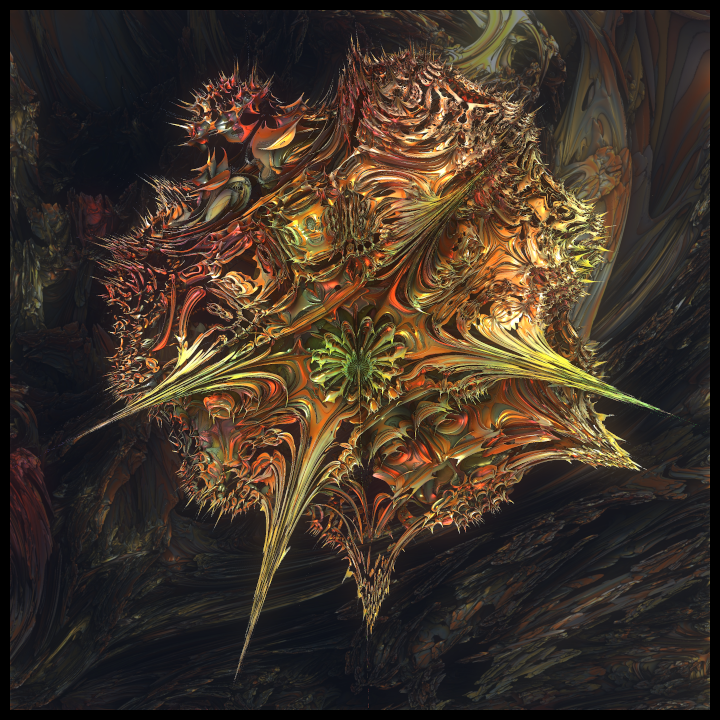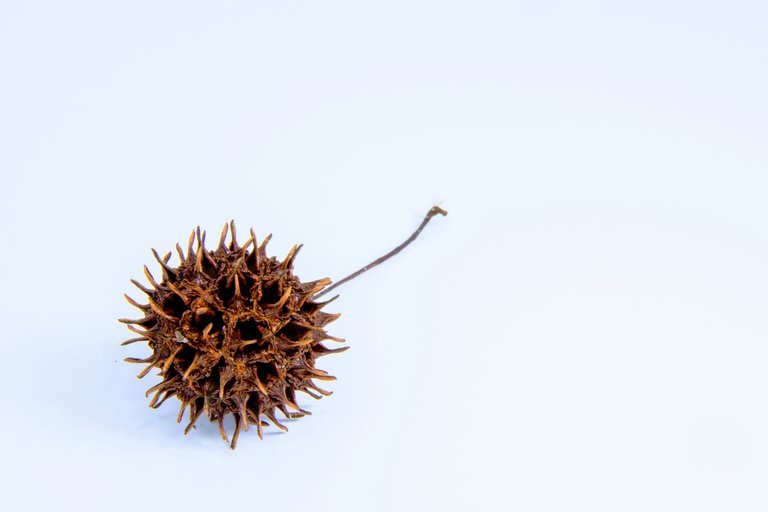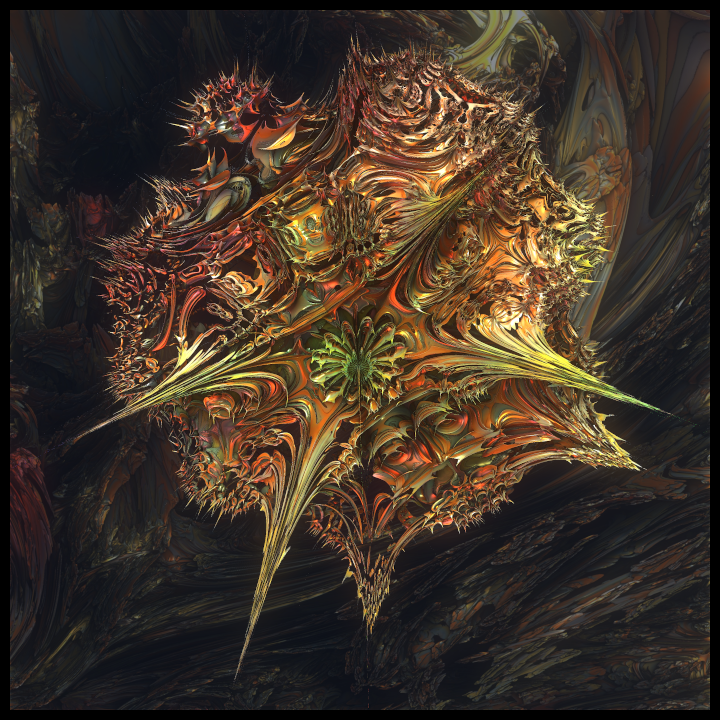
The second portion of a story inspired by @nyarlahotep's amazing fractal ... since it is a forbidden fruit, today we find out why ...
Four hours later, Chief Inspector Dubois was standing in the oldest stand of imported sweet gum trees in France, in their early summer magnificence … lush and verdant, with very few of their seedpods yet dry and fallen. He knew the sight well, and yet it was somehow strange … from childhood he had seen trees old and young together where they were found in their natural habitat in Louisiana. Granted, there had been a sizable fire in this stand … but something was off in addition to that.
While in the air, Chief Inspector Dubois's Australian counterpart had gotten some information for him: the park in Victoria had been upgrading its trees, and had just gotten in the new sweet gums – a new varietal called “Purple Passion” – a new variety known for its vivid purple fall colors. Sweet gums were known to give shades of purple depending on the cultivar, but this one was going to “pop purple,” according to its billing.
By “new variety,” what was meant was that it was just abundant enough to mass market, and only about 40 years old – just a little bit older than that fire near Chiapas and the replacement of those trees with new sweet gums, and a little bit older than the young trees in this stand.
It was summer – no fall colors to distinguish one type of sweet gum tree from another. Yet there had to be something … and there was. A regular sweet gum seed pod looked like this when dry:
(Photo by David Brooke Martin on Unsplash)
Yet all the young trees had pods that looked like this:

Chief Inspector Dubois examined this pod carefully – first of all, it was one of the most beautiful objects he had ever seen. It had apparently come out early in the spring for sweet gum seed pods – March – and so was half-dry by July, with richer colors and textures than an ordinary pod. The standard brown was lavishly joined by pale green and rich coral – and beyond that, the ridged bark known to sweet gums also partook in the rich coral coloring.
Chief Inspector Dubois thought about what Mère Dubois and his sisters would have done with such bark and such pods … these would not be burned, but made into all kinds of crafts and holiday decorations.
“Is this approximately the same kind of tree as was in Victoria – and Chiapas?” he asked aloud.
“Yes.”
“Si.”
“Oui.”
“Uniquely shaped seed pods, gorgeous rich coral colors in the bark and pods, purple and red foliage in the fall and a blue touch in the spring and summer,” the Australian investigator said.
That and the craft potential of the pods … and, even the resin looked delicious. A nice-sized drop caught Chief Inspector Dubois's eyes … pale golden as ever, but almost opalescent with coral flashes. Had he seen it as a boy, that would have been an irresistible invitation for a snack … natural chewing gum.
But now he was a man of 52 … and what was it that had been said about the forbidden fruit of old? It was good-looking, good for food, and desirable to make one wise? This tree was hitting on two of three aspects – everything about it was gorgeous, and everything that one could do with the sweet gum in terms of living ornamentation, woodwork, and crafts would be done even more beautifully with this varietal. Although one would never eat the fruit – the seed pod – of this tree, the resin indeed looked delicious.
Wisdom was substituted for profit in terms of the “Purple Passion” sweet gum varietal – who ever had made that was making good money, so good that they had likely burned down some native sweet gums in Chiapas and in this old grove to make room to grow them somewhere out of the way. This fact, by itself, did, by itself, put the case into the class of wildlife crimes for which Interpol could send an incident response team to Mexico and to Victoria, because the international wildlife crime was, in essence, continuing, with these plants setting seeds and possibly forming hybrids with the true native sweet gums.
And then there was the fact that when these trees burned, people died downwind by the hundreds and sickened by the thousands … when Chief Inspector Dubois stood a long way back from the younger trees and observed, it came to him.
“Now who done did this here?” he murmured to himself. “Père Dubois, your son may call you to have you loan him many, many switches for many, many derriers.”
This varietal of sweet gum was blue-green in the spring and summer, blue-red – hence, markedly purple – in the autumn. Blue was not a common pigment in plant life and very rare outside of certain flowers … however, there was a chemical agent that was common in the forbidden parts of fruits, generally locked in the seeds yet sometimes concentrated heavily in the leaves of plants such as sorghum in the fall. Temperature change – drought or fire – could bring it out of any plant that possessed and it would account for the blue tint – technically, cyan, in the leaves of this varietal.
Chief Inspector Dubois took a leaf off of the nearest tree to him, and used that to take that delicious-looking piece of resin off off it. The resin was actually pale golden-green instead of the pale gold he remembered. He mashed it a little, and then held it at a distance … the aroma came faintly to his nose shortly … the odor was very like what he remembered from childhood, but different … more bitter, almost like … as if someone had taken a great bunch of licorice and pounded it together with bitter almonds.
Hydrocyanic acid, a liquid form of cyanide, had the odor of bitter almonds, and in high enough concentrations, was indeed pale blue. If the concentration was high enough to smell in the resin – and see too, for a touch of pale blue in gold made golden-green – and could be seen in the leaves, then that meant the whole tree was a cyanide bomb, waiting on a lightning strike or power flash to release its chemical warfare payload of hydrogen cyanide downwind.
There were hundreds of these trees just in this stand.
There were hundreds of survivors among the native trees of Chiapas.
There were dozens of survivors in the remodeled park in Victoria.
There were uncounted hundreds if not thousands of saplings of this tree being shipped who knew where as desirable ornamentals, to that very moment … each of those saplings represented an international wildlife crime risen to the level of a crime against humanity for profit.
However, they would be easy enough to find … the tree of death set a gorgeous forbidden fruit, so unlike that of other sweet gums that they would be easy to find. Even if these trees hybridized with proper sweet gums, their immediate offspring would likely still be notable because of their having some characteristics in their seed pods in common with their deadly parent.
Ironically, the only part of the tree not loaded with hydrocyanic acid was the seed pod with all its contents – the tree had to spread its seed without killing those animals who would help it. So, in theory, the chief inspector could have sent the gorgeous seed pod home to his mother – none of the people who had purchased the “Super Craft Sweet Gum Balls” and had those pods were in any danger.
Nonetheless, Interpol did not play – the only thing those pods would ornament was the evidence presented by prosecutors against those that had tampered with the genetic code of the “Worplesdon” varietal, a third of which leaves turned purple in the fall. The idea had been to turn more of its leaves from orange and red into a uniform purple – hence the tweaking of the genetic code so the trees would produce blue … but in addition to producing shikimic acid, normal to sweet gum trees, the resulting trees were making blue through making hydrocyanic acid!
Still, the seed pod of the tree of death remained one of the most beautiful objects Chief Inspector Dubois had ever seen – its unmistakable appearance helped Interpol to assist 96 of its 194 member countries in eradicating every one of the trees of death from the earth before another life was lost.
Ahhh, very cool story indeed! Do not mess with nature's genetics, or there will be revenge taken! Beautiful & colorful trees of death, such an irony... Thank you for bringing this fractal to full ... fruitiion :)
"Fruition"😁 🤣 😂 🤣 😂 😀
I went to visit a friend once, and where I got off the bus there were all these sweet gum seed pods EVERYWHERE ... they are a nuisance, but that started my interest in the tree itself, and they are GORGEOUS in the fall. When I saw your fractal, the resemblance to the pods was marked ... your fractal is more beautiful and would be a darling of crafters everywhere, but then I had to think about what would have to be done to get from what exists to what you have and why someone might do that ... increasing the purple would be obvious, but then I thought about the fastest way to do that ... and hydroCYANic acid has blue in its name (cyan, the C in the CMYK all printers know so well) and occurs in many actual plants... the rest you know...
Very well thought out, bravo! I caught myself thinking of the inspector as I was making the next fractal, let's see if it can be an inspiration for yet another "weird crime" story...
The inspector's appearance will be partially determined by how much writing time I have per week ... for example, right now I am working on an extended piece for The Ink Well and also a different kind of art collection post for the Sketchbook community ... still, July is before us ... the inspector will be available later in the month, Lord willing